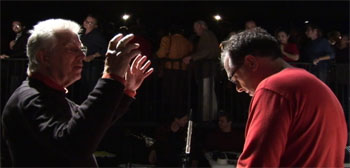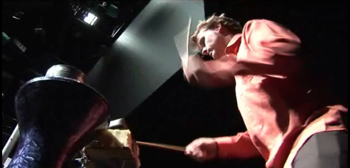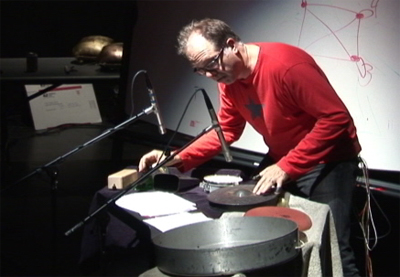Pulitzer Prize-Winning Calit2 Composer in Residence Roger Reynolds to Premiere New Work at National Gallery of Art
San Diego, CA and Washington, DC, November 14, 2007 -- For UC San Diego composer and Calit2 Composer in Residence Roger Reynolds, the Nov. 18 premiere of his ambitious work "Sanctuary" at the National Gallery of Art marks the culmination of a three-year creative process.
|
"This is a particularly satisfying project because of the high level of collaborative interaction," Reynolds said of the piece that brings together live percussion with computer, sound and video technologies. "It is a rare pleasure to be able to work over an extended period of time with such gifted and imaginative partners."
Reynolds, who won the Pulitzer Prize for music in 1989, composed "Sanctuary" for UCSD percussionist Steven Schick after Schick called his attention to the unique theatricality of percussion performance and urged him to take on such a project.
Onstage, virtuoso percussionists such as Schick who perform new and experimental music combine gestures and movements with arrays of instruments that become stage sets. "Sanctuary" also includes real-time computer processing and special lighting effects. The piece, Reynolds said, is informed by theater, dance, video and perceptual psychology.
|
Calit2 is also documenting the project for a TV documentary, and two Calit2 producer-cameramen, Alex Matthews and Hector Bracho, left today for Washington D.C. to capture final rehearsals and the Nov. 18 premiere for the documentary, shot in high-definition video.
The premiere of "Sanctuary" is presented in celebration of the National Gallery's exhibit, "Let the World In: Prints by Robert Rauschenberg."
|
"Sanctuary" was composed for Schick, a world-renowned performer, and UCSD percussion quartet red fish blue fish . Both will perform at the premiere.
The piece consists of three movements: a solo for Schick called "Chatter/Clatter"; and "Oracle" and "Song" for red fish blue fish.
Thematically, "Sanctuary" continues Reynolds' exploration of ancient and modern cultures and myths. In classical Greece, temples offered sanctuary and served as places for contemplation. Amid today’s global political and social strife, sanctuary can be a place of tolerance or privilege, also a safe haven for expression, experimentation and revelation, Reynolds said.
Technology adds impact to "Sanctuary" through judicious amplification and sound positioning that allow the music to surround the audience.
|
Music Department graduate student Ian Saxton worked with Reynolds to realize the composer's intentions in moving sound through the performance space. As a result, Reynolds said, the sound "morphs gradually over time, losing some of its original characteristics and acquiring new ones. Singular events proliferate into flock-like collections that swoop and glide around the listener."
"Sanctuary" utilizes the unique architecture and acoustics of renowned architect I.M Pei's National Gallery East Wing. The piece will be performed there, in the East Building Auditorium and the atrium beneath artist Alexander Calder’s magisterial mobile "Untitled."
Reynolds has been a pioneer in utilizing grand public spaces dating back to the world premiere in 2000 of his piece "Justice" at the Library of Congress's Thomas Jefferson Building.
The "Sanctuary" concert opens a year-long French-American music festival that is a collaboration between the Washington, D.C.-based Contemporary Music Forum and the French Embassy in the United States. Reynolds is the festival’s principal American composer.
"Sanctuary" is a co-commission by the red fish blue fish percussion ensemble, the National Endowment for the Arts, the Contemporary Music Forum and the Randy Hostetler Living Room Fund.
Related Links
The Sanctuary Project
National Gallery of Art
Roger Reynolds Website
Roger Reynolds Collection at the Library of Congress
red fish blue fish
Media Contacts
Media Contact: Dirk Sutro, 858-534-4830, dsutro@ucsd.edu




